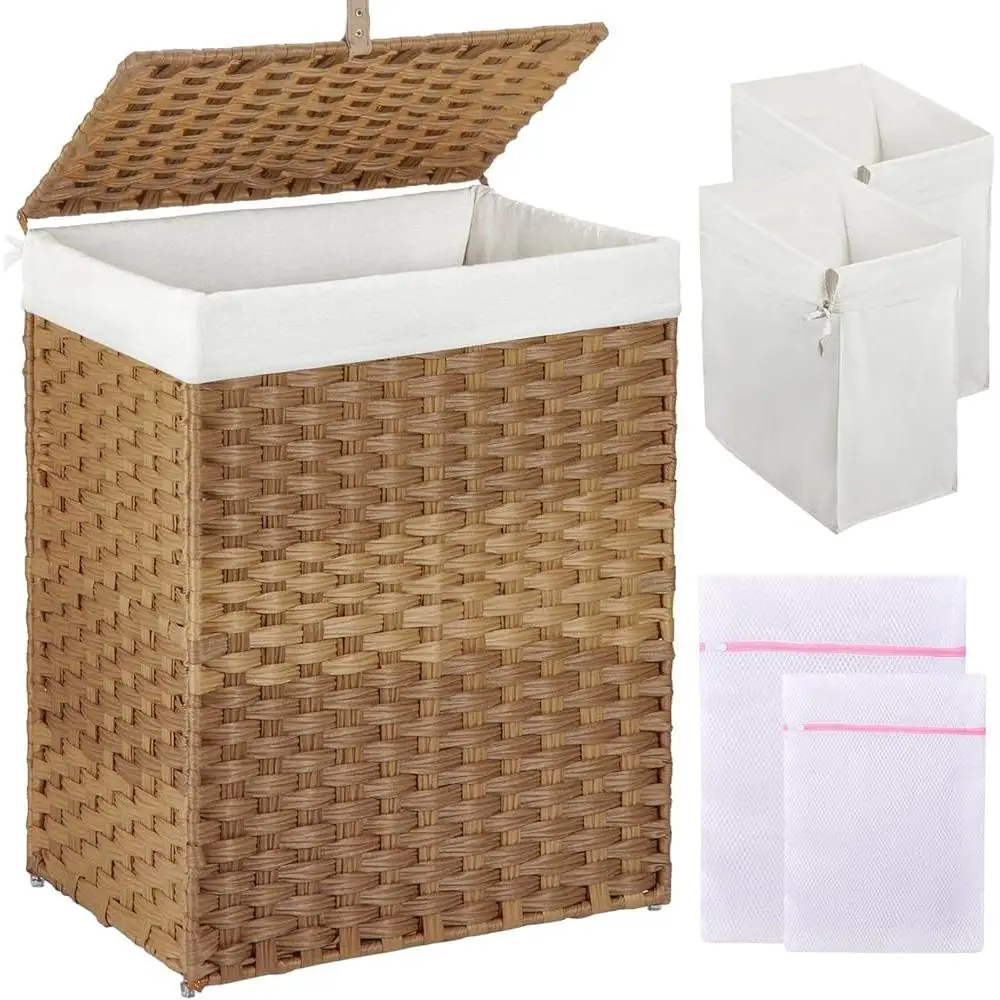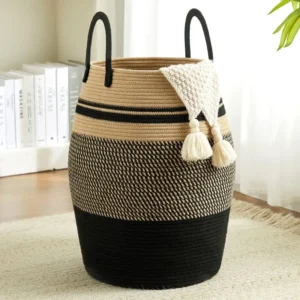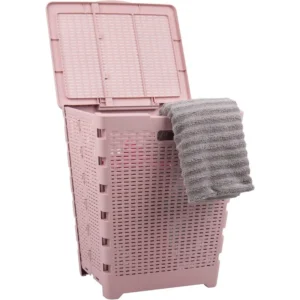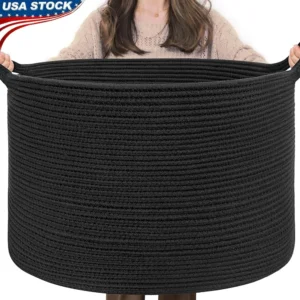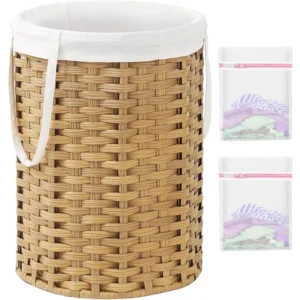What’s the Difference Between a Laundry Basket and a Hamper?
While they both play crucial roles in laundry management, laundry baskets and hampers serve distinctly different purposes in your home. A laundry basket is primarily designed for transporting clothes—whether that’s carrying dirty clothes to the washing machine or bringing clean, folded clothes back to your closet. In contrast, a hamper functions as a dedicated storage container for dirty clothes until laundry day arrives.
Many homeowners use these terms interchangeably, leading to confusion when shopping for the right laundry solution. Understanding the differences between hampers and baskets helps you create a more efficient laundry system tailored to your specific needs. Each item has unique features that make it better suited for certain tasks within your laundry routine.
The key is recognizing that these aren’t competing products but complementary pieces in a well-organized home. Many households benefit from having both, as they serve different functions in the laundry hamper vs basket differences that make up a complete laundry management system. Let’s explore their distinctive characteristics to help you determine which one—or perhaps both—will best serve your household.
Key Features of Laundry Baskets: The Transportation Specialist
Laundry baskets excel at mobility, designed specifically to move clothes efficiently from one location to another. Their open-top design allows for quick loading and unloading, while sturdy handles make them comfortable to carry even when fully loaded with heavy wet clothes from the washing machine.
Most laundry baskets feature a lightweight yet durable construction that prioritizes functionality over aesthetics. The open design isn’t just for convenience—it also promotes air circulation, which is especially beneficial when transporting damp clothes that need ventilation to prevent musty odors from developing.
Our woven laundry baskets collection showcases the variety of options available, from traditional to contemporary designs. Laundry baskets typically offer these key features:
- Open-top design for easy access and loading
- Sturdy handles positioned for balanced carrying
- Lightweight construction for easy transportation
- Ventilated sides to prevent moisture buildup
- Variety of shapes (round, rectangular, oval, hip-hugging)
- Durable materials that withstand repeated use
- Often stackable or collapsible for storage when not in use
- Shallow enough to reach the bottom easily
The defining characteristic of a quality laundry basket is its ergonomic design that makes the physical task of moving laundry as effortless as possible, whether you’re carrying it to the laundromat or just up and down the stairs in your home.
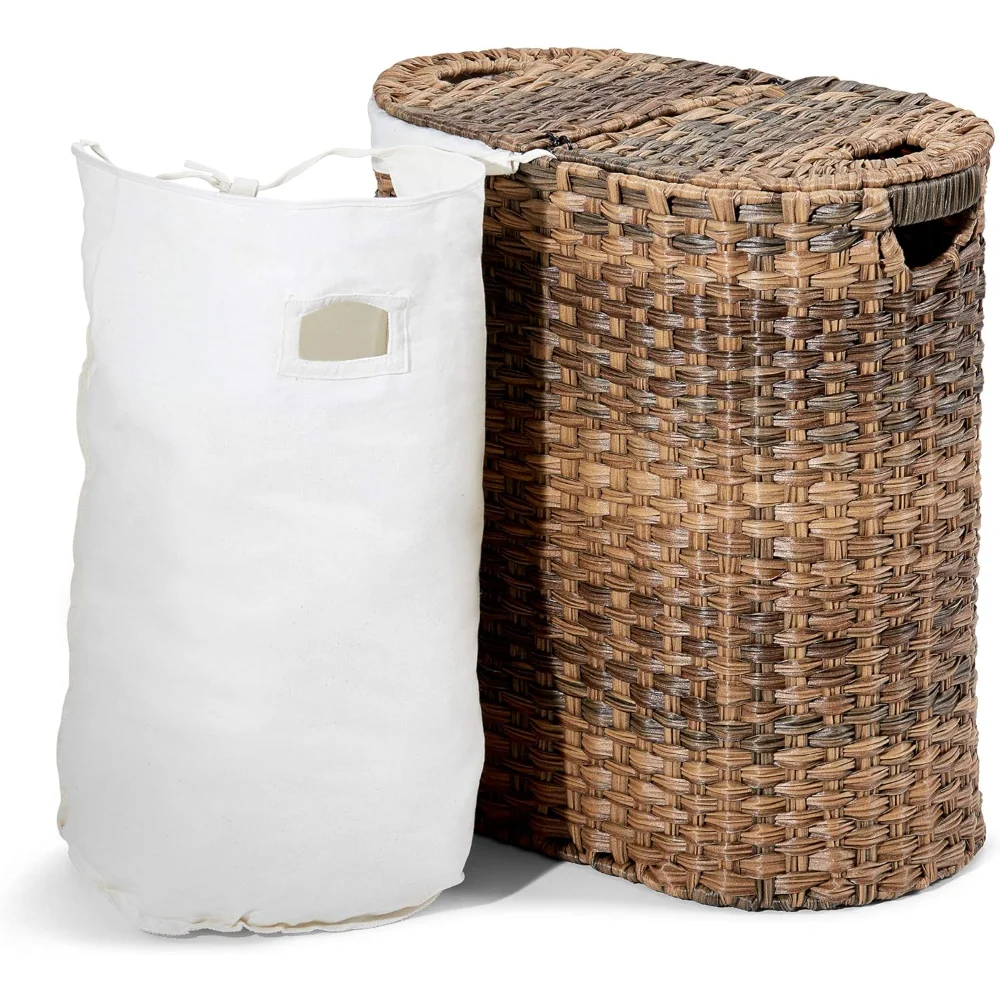
Key Features of Laundry Hampers: The Storage Solution
Unlike their basket counterparts, laundry hampers are designed to be stationary collectors of dirty clothes, often positioned in bedrooms or bathrooms where clothes are most commonly removed. Their primary purpose is containment rather than transportation, which is reflected in their distinctive design elements.
Hampers typically feature a taller, more upright construction that maximizes vertical space while maintaining a relatively small footprint in your room. Many hampers include lids that serve the dual purpose of concealing unsightly dirty clothes and containing odors until wash day arrives.
Our wicker hampers with lids showcase how functional storage can also be aesthetically pleasing. The key features that define a laundry hamper include:
- Taller, more vertical design for efficient space use
- Often includes a lid to conceal contents and contain odors
- Decorative exterior designed to complement room décor
- Sturdy construction meant to remain in one location
- Made from materials like wicker, rattan, canvas, or plastic
- Sometimes includes interior dividers for pre-sorting clothes
- Ventilation features to prevent mildew in dirty clothes
- Various sizes to accommodate different household needs
The defining characteristic of a quality hamper is its ability to store dirty clothes discreetly and hygienically while adding to—rather than detracting from—your room’s overall aesthetic. Unlike baskets, hampers are designed with the understanding that they’ll be visible in your living space for extended periods.
Side-by-Side Comparison: Basket vs. Hamper
Understanding the fundamental differences between laundry baskets and hampers helps you determine which option—or combination of both—will best serve your household’s needs. The following comparison highlights the key distinctions:
| Feature | Laundry Basket | Laundry Hamper |
|---|---|---|
| Primary Function | Transportation of clothes | Storage of dirty clothes |
| Portability | Highly portable with handles | Limited mobility, designed to stay in place |
| Lid/Cover | Typically open-top | Often includes lid or closure |
| Ventilation | Maximum airflow through open design | Strategic ventilation despite more enclosed design |
| Structure | Wide, shallow, open construction | Taller, more enclosed construction |
| Typical Placement | Laundry room, temporarily in bedrooms | Permanent fixture in bedrooms or bathrooms |
| Size/Capacity | Moderate, designed for single loads | Larger, designed to accumulate clothes over time |
| Common Materials | Plastic, mesh, fabric, woven natural fibers | Wicker, rattan, canvas, decorative fabrics |
| Aesthetic Emphasis | Function over form | Balances function with decorative appeal |
This fundamental difference in purpose explains why many households benefit from having both items as part of their laundry hamper vs basket system. Hampers collect dirty clothes where they’re removed, while baskets transport those clothes to and from the washing machine when it’s time to do laundry.
When to Choose a Laundry Basket: Ideal Use Cases
Laundry baskets shine in situations where mobility is a priority in your laundry routine. They’re the perfect solution when:
- You need to transport clothes to a laundromat or shared laundry facility
- Your home has multiple levels with bedrooms upstairs and laundry facilities downstairs
- You wash smaller loads more frequently rather than accumulating large amounts of laundry
- You fold clothes in one location (like the living room while watching TV) but store them elsewhere
- You have limited storage space and need something that can be tucked away when not in use
- You deal with damp items like towels or workout clothes that benefit from air circulation
- You need to carry clean, folded clothes back to multiple bedrooms
Our wicker laundry baskets collection offers traditional options that combine functionality with subtle style. Laundry baskets are particularly well-suited for:
- College students in dormitories
- Apartment dwellers using shared or off-site laundry facilities
- Families that distribute clean clothes to multiple bedrooms
- Those with laundry rooms located far from where clothes are worn and removed
- People who prefer more frequent, smaller loads of laundry
The key benefit of choosing a basket is the convenience it provides during the active phases of doing laundry—washing, drying, folding, and distributing clean clothes.
When to Choose a Laundry Hamper: Ideal Use Cases
Laundry hampers excel in situations where storage, containment, and aesthetics are priorities. They’re the ideal choice when:
- You accumulate dirty clothes over several days before washing
- You need to contain odors from dirty clothes or gym wear
- Your laundry collection point is in a visible area of your bedroom or bathroom
- You prefer to pre-sort clothes by color or fabric type before washing
- You want your laundry solution to complement your room’s décor
- You need to maximize vertical space rather than floor area
- You want to conceal dirty laundry from view
Our wicker laundry hampers collection features options specifically designed for these scenarios. Hampers are particularly well-suited for:
- Master bedrooms and en-suite bathrooms
- Households that do laundry weekly rather than daily
- Families with children who need a designated place for dirty clothes
- Those who prioritize home aesthetics and want laundry solutions that blend with décor
- People with limited floor space who need vertical storage solutions
- Situations where containing odors from sports gear or work clothes is important
The primary advantage of choosing a hamper is its ability to store dirty laundry in an organized, contained, and visually appealing manner until you’re ready to wash it.
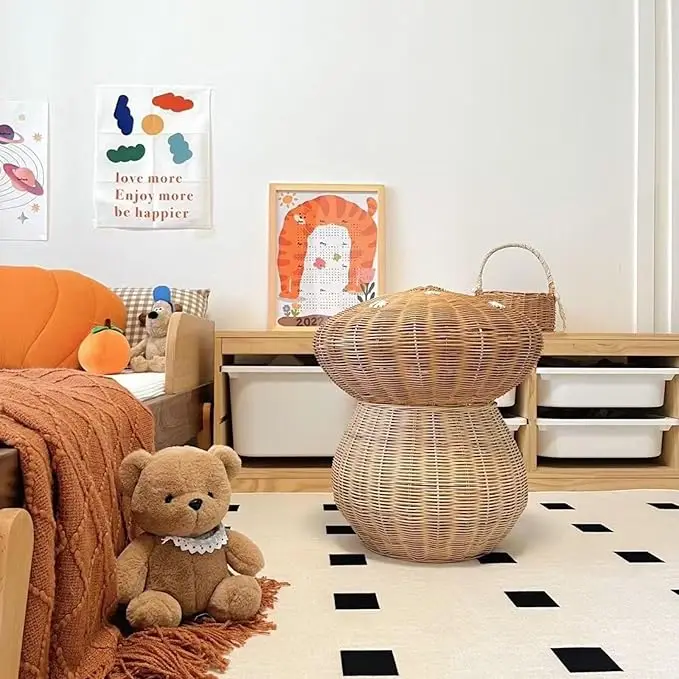
Advantages and Drawbacks of Laundry Baskets
Understanding both the benefits and limitations of laundry baskets helps you make an informed decision about their role in your laundry system. When comparing laundry hampers vs baskets comparison, consider these factors:
Advantages:
* Superior portability makes transporting laundry easier
* Open design provides excellent ventilation for damp items
* Versatile use beyond laundry (toy storage, grocery carrying, garden harvesting)
* Many collapse or nest for space-efficient storage when not in use
* Generally more affordable than decorative hampers
* Easy to clean with simple wiping or occasional washing
* Lightweight even when empty, making them easy to maneuver
Drawbacks:
* Contents are always visible, which can look untidy
* Limited odor containment due to open design
* Rarely designed to complement room décor
* Typically smaller capacity than hampers
* Must be stored somewhere when not in active use
* Not ideal for long-term clothes storage between wash days
* Open top allows dust to settle on contents
The ideal scenario for a laundry basket is active use during the laundry process itself, rather than as a long-term storage solution for dirty clothes.
Advantages and Drawbacks of Laundry Hampers
Similarly, laundry hampers have their own set of strengths and limitations that make them better suited for certain aspects of laundry management. When deciding which is better between a laundry hamper vs basket, consider these factors:
Advantages:
* Effectively conceals dirty laundry from view
* Contains odors with enclosed design, often with lids
* Aesthetically designed to complement home décor
* Larger capacity for accumulating clothes between wash days
* Many offer dividers for pre-sorting clothes by color or fabric
* Remains stationary, creating a consistent drop-off point for dirty clothes
* Vertical design maximizes storage while minimizing floor space use
Drawbacks:
* Limited mobility due to heavier construction
* May create ventilation issues that lead to musty odors if not properly designed
* Takes up permanent floor space in rooms
* Generally more expensive than basic laundry baskets
* Can be difficult to clean thoroughly, especially woven materials
* Bottom items may be forgotten or difficult to reach
* Less versatile for other household uses
The ideal scenario for a hamper is as a stationary collection point where dirty clothes can accumulate between laundry days while remaining organized and out of sight.
The Perfect Combination: Using Both for Optimal Laundry Management
Many households find that the most efficient laundry system incorporates both hampers and baskets in complementary roles. This combination creates a seamless workflow that addresses every stage of the laundry process.
In this dual system, hampers serve as collection points in bedrooms and bathrooms, where clothes are naturally removed. Their aesthetic design and odor-containing features make them ideal for this role, allowing dirty clothes to accumulate discreetly until laundry day.
When it’s time to wash, a laundry basket comes into play as the transportation tool. Clothes are transferred from hampers to baskets, which are then carried to the washing machine. After washing and drying, the same basket becomes the perfect tool for carrying clean clothes to folding areas and then distributing them back to their proper locations.
This complementary approach, as detailed in our laundry hampers vs baskets buying guide, creates a complete system that addresses the entire laundry cycle:
- Collection (hamper)
- Transportation to laundry area (basket)
- Washing and drying (machines)
- Transportation to folding area (basket)
- Distribution of clean clothes (basket)
For larger households, this combined approach is particularly valuable, as the volume of laundry makes efficient processes especially important. While it requires a larger initial investment, the improved functionality often justifies the cost.
Material Matters: Choosing the Right Construction
The material of your laundry storage solution significantly impacts its functionality, durability, and appearance. Different materials offer distinct advantages depending on your specific needs.
For laundry baskets, common materials include:
- Plastic: Highly durable and easy to clean, plastic baskets are moisture-resistant and maintain their shape even when carrying heavy wet loads. They’re ideal for active use but less aesthetically pleasing.
- Mesh/Fabric: Lightweight and often collapsible, these baskets excel in portability and storage efficiency when not in use. They’re typically less durable than rigid options but are gentle on delicate fabrics.
- Natural Fibers: Woven baskets made from rattan, bamboo, or other wicker vs woven laundry baskets materials offer a balance of functionality and natural beauty. They provide good ventilation but require more careful handling.
For hampers, material options include:
- Wicker/Rattan/Bamboo: These natural materials offer excellent aesthetic appeal and good ventilation, making them popular for visible placements in bedrooms. They require occasional dusting and should be kept from excessive moisture.
- Canvas/Fabric: Soft-sided hampers are lightweight and sometimes collapsible. Many feature washable liners for easy cleaning and come in various patterns to match room décor.
- Plastic: Durable and moisture-resistant, plastic hampers are practical for bathrooms or children’s rooms where easy cleaning is a priority.
When selecting materials, consider where the item will be placed, how frequently it will be used, and whether appearance or pure functionality is your priority. For items that will be visible in living spaces, natural materials often offer the best combination of functionality and aesthetic appeal.

Specialized Options for Unique Laundry Needs
Beyond standard baskets and hampers, specialized laundry storage solutions address specific household challenges and preferences:
Rolling Hampers and Baskets
These mobility-enhanced options feature wheels for easy movement, perfect for those who struggle with lifting heavy loads or have laundry facilities located far from living areas. Some rolling hampers combine storage and transport functions with removable bags inside a decorative frame.
Collapsible Options
For homes where space is at a premium, collapsible laundry baskets offer functionality when needed and compact storage when not in use. These range from pop-up mesh designs to semi-rigid options with reinforced sides that fold flat.
Hanging Hamper Bags
Ideal for tiny spaces like dorm rooms or small apartments, these door-hanging options use vertical space rather than floor area. They’re also excellent for temporary use in guest rooms.
Multiple-Bin Sorters
These hampers feature divided compartments for pre-sorting laundry by color, fabric type, or washing temperature. They streamline the washing process by eliminating the sorting step on laundry day.
Backpack Laundry Bags
Popular with college students and urban apartment dwellers, these convertible bags transform from hampers to backpacks for hands-free transportation to laundry facilities.
Each specialized option addresses specific lifestyle needs, making laundry management more efficient in challenging living situations. When standard solutions don’t quite fit your circumstances, these alternatives offer tailored functionality.
Wicker Laundry Baskets, Woven Laundry Baskets, Woven Storage Baskets
$392.02 Select options This product has multiple variants. The options may be chosen on the product pageLarge Wicker Laundry Baskets, Tall Wicker Baskets, Woven Laundry Hampers, Woven Storage Baskets
$130.54 Select options This product has multiple variants. The options may be chosen on the product pageWoven Laundry Baskets, Woven Laundry Washing Baskets
Price range: $136.76 through $581.37 Select options This product has multiple variants. The options may be chosen on the product pageWicker Hampers with Lids, Wicker Laundry Baskets with Lids, Wicker Laundry Hampers
$127.33 Select options This product has multiple variants. The options may be chosen on the product pageWicker Blanket Baskets, Woven Laundry Baskets
$89.60 Select options This product has multiple variants. The options may be chosen on the product pageLarge Wicker Laundry Baskets, Rattan Laundry Baskets, Woven Laundry Hampers
$162.32 Select options This product has multiple variants. The options may be chosen on the product page
Is a Laundry Basket or Hamper Better for Your Home?
Determining whether a laundry basket or hamper—or both—is right for your home depends on several key factors specific to your household:
Space Considerations
If you’re working with limited space, evaluate where your laundry storage will live. Hampers work well as permanent fixtures in corners of rooms, while baskets can be stored away when not in use. For truly compact living, hamper vs basket small laundry solutions offer specialized options.
Laundry Frequency
Consider how often you do laundry. Daily or every-other-day washing routines benefit from baskets for quick transport, while weekly washing schedules make hampers more valuable for accumulating clothes between wash days.
Household Size
Larger households typically generate more laundry, making a combination system most practical—hampers for collection and baskets for transportation. Single-person households might manage with just one or the other, depending on laundry facilities’ location.
Aesthetic Priorities
If your laundry storage will be visible in living spaces, hampers offer more decorative options designed to complement home décor. If functionality is your only concern, baskets provide the most practical solution.
Budget Considerations
Quality baskets typically cost less than decorative hampers. If budget constraints are significant, start with whichever addresses your most pressing need, with plans to add the complementary piece later.
The ideal solution balances these factors according to your specific situation, creating a laundry system that works seamlessly with your lifestyle and living space.
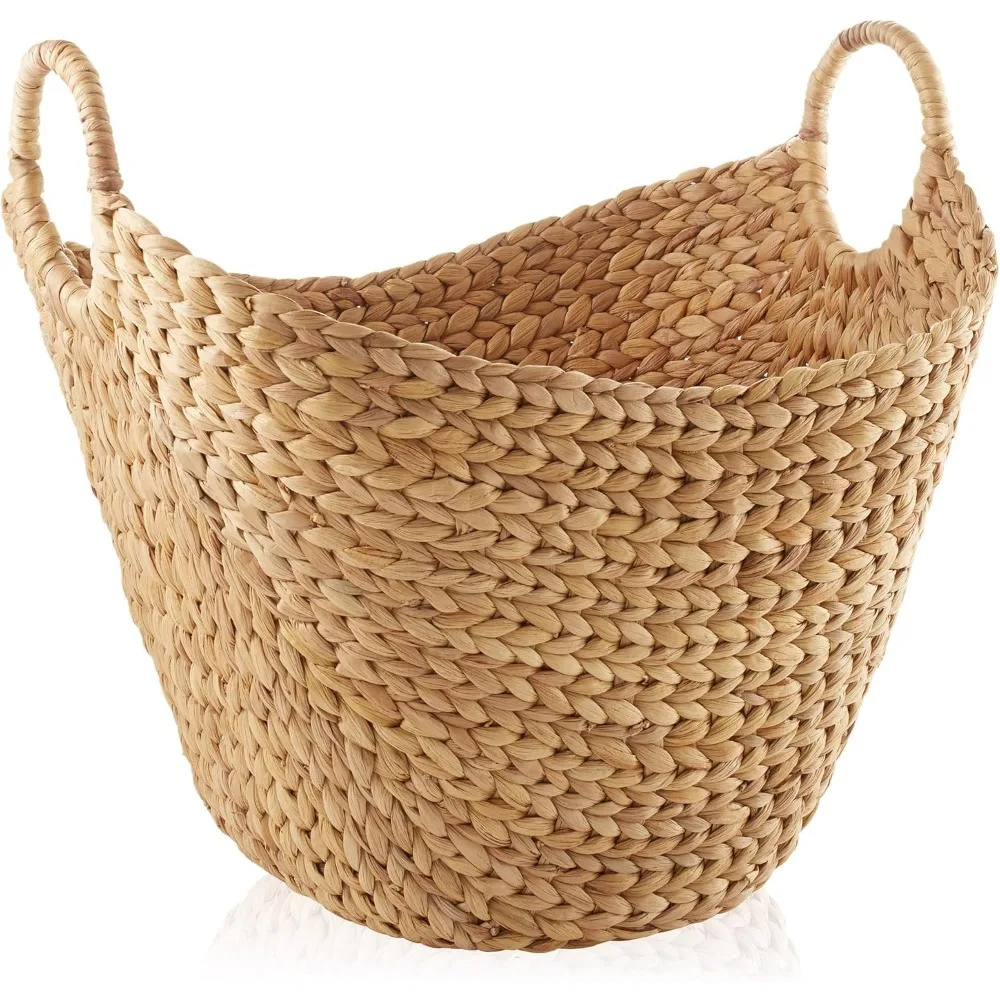
How to Maintain Your Laundry Basket or Hamper
Proper maintenance ensures your laundry storage solutions remain functional and attractive for years to come. Different materials require specific care approaches:
Plastic Baskets and Hampers
* Clean regularly with warm, soapy water
* Disinfect occasionally with diluted bleach solution (1 tablespoon bleach to 1 gallon water)
* Check for and smooth any rough edges that might snag clothes
* Store in dry locations to prevent mildew
Fabric Hampers and Bags
* Follow manufacturer’s washing instructions, typically machine washing on gentle cycle
* Air dry completely before using again to prevent mildew
* Treat stains promptly with appropriate fabric cleaners
* Replace liners if they become stained or worn
Natural Fiber Baskets and Hampers
* Dust regularly with a soft brush or cloth
* Spot clean with minimal water and mild soap
* Air outside occasionally to freshen
* Treat with food-grade mineral oil once yearly to maintain flexibility in natural fibers
* Keep away from excessive moisture that could cause warping or mold
For all types, empty completely on a regular basis to check for forgotten items and clean the bottom where lint and debris accumulate. Proper maintenance not only extends the life of your laundry storage but also helps keep your clothes fresh and clean.
Our laundry solutions collection includes options designed for easy maintenance and lasting durability.
Frequently Asked Questions About Laundry Storage
Can a laundry basket be used as a hamper?
While possible, it’s not ideal. Laundry baskets lack lids to contain odors and are designed for transport rather than long-term storage. However, in small spaces or temporary situations, a basket can serve as a hamper if needed.
What’s best for preventing odors from dirty laundry?
A lidded hamper with ventilation features provides the best odor control. Look for designs with breathable materials like wicker or those with strategic air holes that allow airflow while containing smells.
How big should my laundry basket or hamper be?
For hampers, consider your household size and laundry frequency. A single person might need just 1.5-2 cubic feet, while a family of four might need 3+ cubic feet. Laundry baskets should comfortably hold a single load of laundry from your washing machine.
Are lidded hampers always better than open ones?
Not necessarily. Lidded hampers excel at containing odors and presenting a tidier appearance but may contribute to mildew if clothes are damp. Open hampers provide better ventilation but leave dirty clothes visible.
Where should I place laundry storage in my home?
Hampers work best where clothes are removed—bedrooms and bathrooms. Baskets are most useful when stored near laundry facilities but can be kept wherever is convenient for your routine.
How often should I clean my laundry storage?
Plastic baskets should be wiped down monthly. Fabric hampers should follow manufacturer’s washing recommendations, typically every 1-3 months. Wicker and natural fiber items should be dusted weekly and spot-cleaned as needed.

